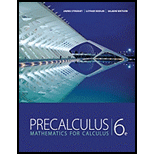
Concept explainers
To estimate : The rate of population growth in 1920 and in 1980 by averaging the slopes of two secant lines.
Answer to Problem 34E
The rate of population growth on 1920 and in 1980 are 16 millions/year and 78.5 millions/year respectively.
Explanation of Solution
Given information:
The table gives the world’s population in the 20th century.
Calculation :
The rate of population growth is the slope of the secant line.
The slope of the secant is given by:
where P is population.
For population growth in 1920, there is two secant lines over the intervals
So, the secant line over the interval
Similarly, the secant line over the interval
So, the average rate at 1920 is:
Similarly, for population growth in 1980, there is two secant lines over the intervals
So, the secant line over the interval
Similarly, the secant line over the interval
So, the average rate at 1980 is:
Hence,
The rate of population growth on 1920 and in 1980 are 16 millions/year and 78.5 millions/year respectively.
Chapter 13 Solutions
Precalculus: Mathematics for Calculus - 6th Edition
 Calculus: Early TranscendentalsCalculusISBN:9781285741550Author:James StewartPublisher:Cengage Learning
Calculus: Early TranscendentalsCalculusISBN:9781285741550Author:James StewartPublisher:Cengage Learning Thomas' Calculus (14th Edition)CalculusISBN:9780134438986Author:Joel R. Hass, Christopher E. Heil, Maurice D. WeirPublisher:PEARSON
Thomas' Calculus (14th Edition)CalculusISBN:9780134438986Author:Joel R. Hass, Christopher E. Heil, Maurice D. WeirPublisher:PEARSON Calculus: Early Transcendentals (3rd Edition)CalculusISBN:9780134763644Author:William L. Briggs, Lyle Cochran, Bernard Gillett, Eric SchulzPublisher:PEARSON
Calculus: Early Transcendentals (3rd Edition)CalculusISBN:9780134763644Author:William L. Briggs, Lyle Cochran, Bernard Gillett, Eric SchulzPublisher:PEARSON Calculus: Early TranscendentalsCalculusISBN:9781319050740Author:Jon Rogawski, Colin Adams, Robert FranzosaPublisher:W. H. Freeman
Calculus: Early TranscendentalsCalculusISBN:9781319050740Author:Jon Rogawski, Colin Adams, Robert FranzosaPublisher:W. H. Freeman
 Calculus: Early Transcendental FunctionsCalculusISBN:9781337552516Author:Ron Larson, Bruce H. EdwardsPublisher:Cengage Learning
Calculus: Early Transcendental FunctionsCalculusISBN:9781337552516Author:Ron Larson, Bruce H. EdwardsPublisher:Cengage Learning





